July 1st, 2010 by sugizaki
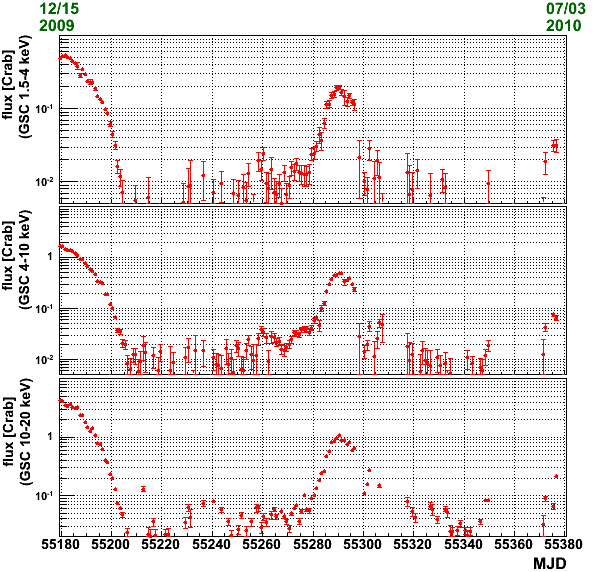
MAXI/GSC has detected X-ray brightening of the Be/X-ray binary
system, A0535+26, since 2010 June 25 (UT). Its brightening has also been
detected by the Fermi/GBM earth occultation, as reported in ATEL #2705.
The possible detection of the brightening by MAXI/GSC was first
noticed on June 27 with a nova-search program involved in the ground
pipeline data-reduction process. The source was observed by GSC #3
camera, which is now in a test operation at a reduced high voltage of
1550V. Since the response calibration at the 1550 V is just being
developed, the data are not currently used in the light curve archived
on the MAXI public-web page. Figure shows the light curve
preliminarily obtained from the GSC #3 data. The brightening since
2010 June 25 (MJD=55372) is clearly seen. The source had been
unobservable until June 23 for the sun-protection area. The fluxes
preliminarily estimated in 4–10 keV band are 43+-6 mCrab on June 25,
75+-6 mCrab on June 28, and 65+-6 mCrab on June 29. The data of June 27
and June 28 are not ready at the moment because the download of
telemetry data during these period is delayed.
June 30th, 2010 by Mitsuhiro Kohama
MAXI team reported three detections of the transient events to Astronomer’s Telegram (ATEL) in Jun, 2010.
And MAXI team also reported one XRF event to GCN: The Gamma-ray bursts Coordinates Network.
June 28th, 2010 by Mitsuhiro Kohama
The real time telemetory down-link had been disabled during
2010/06/25 18:48 and 2010/06/27 06:08. It is because it was necessary to
cool the antenna of ISS that became hot for high soloar
anlge. This data of MAXI at the period was stored in the ISS
recorder. It is scheduled to analyze it again when data is
delivered.
June 9th, 2010 by sugizaki
All mission instruments on the MAXI payload had been tuned off
since 6/5 13:24 to 6/6 08:50 (UT) for an emergent trouble of ISS JEM
ATCS (Active Thermal Control System). The system was now recovered and
the operation returned to the normal observation mode.
June 8th, 2010 by Motoki Nakajima
Following our report “MAXI/GSC detects X-ray brightening of Cir X-1″ issued in Atel #2608,
RXTE and Swift made follow-up observations, in which type-I X-ray
bursts were detected at a position consistent with that of Cir X-1 (Atel #2643, #2650, #2651, #2653).
We re-examined the data of the MAXI persistent/non-bursting source in
the Cir X-1 region. We detected only one source at the position of
(RA,DEC) = (230.04 +- 0.05, -57.27 +/- 0.03) (errors are statistical
only). Considering the positional systematic error of 0.2 degree, the
source location is consistent with that of Cir X-1. Furthermore,
MAXI/GSC detected an X-ray burst at 2010-05-29 15:50:50, confirming the
detections by RXTE and Swift. The two energy-band light curve is shown
in the figure, which suggest spectral softening during the decay phase
indicative of the type-I (thermonuclear) nature or the burst.
We thank Dr. Linares for encouraging this reanalysis.
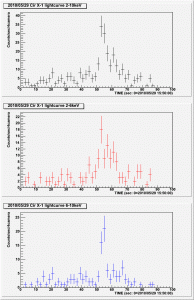
May 31st, 2010 by Mitsuhiro Kohama
MAXI team reported one detection of the transient events to Astronomer’s Telegram (ATEL) in May, 2010.
And MAXI team also reported one GRB event to GCN: The Gamma-ray bursts Coordinates Network.
May 11th, 2010 by Mikio Morii
MAXI/GSC detected GRB 100510A on 2010-05-10 from 19:27:09 to
19:27:37 (UT). It is temporary coincident with the Fermi-GBM Trigger
#295212428. The source is clearly seen in the all-sky image (top
figure). The error region is shown in the middle figure. Here, the 90%
statistical error region is shown in small box, assuming the constant
flux during the 50 sec scan transit of MAXI FoV. The larger box shows
the error region without assumptions on the source constancy. The
upper-right region (a part of large circle) shows the error region of
Fermi-GBM flight position (The ground position is inconsistent with the
MAXI position). The bottom figure shows the light curve of the burst.
The details are reported in the GCN circular.
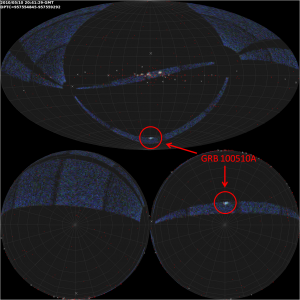
Top: All sky plot in galactic coordinate. Bottom left: Northern hemisphere. Bottom right: Southern hemisphere.
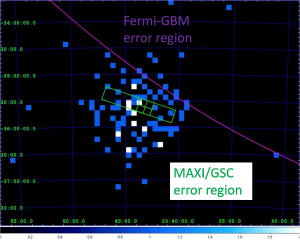
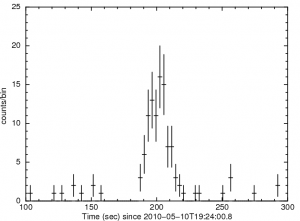
May 10th, 2010 by Tatehiro Mihara
On April 17, the space shuttle left the ISS and the ISS attitude
returned to normal. Now the south camera looks south. The first
calibration for 1550V cameras were done. All-sky maps were replotted
using both 1650V and 1550V cameras since April 11. One camera (A-camera
#0) is still out of operation leaving a small blank in the all-sky map.
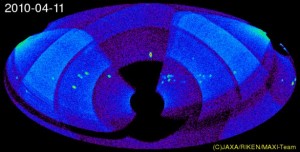
all sky image on April 11, 2010.
April 30th, 2010 by Mitsuhiro Kohama
MAXI team reported 0 detection of the transient events to Astronomer’s Telegram (ATEL) in April, 2010.
And MAXI team also reported one GRB event to GCN: The Gamma-ray bursts Coordinates Network.
April 15th, 2010 by Tatehiro Mihara
MAXI is located in the front (moving direction of ISS ) in the
normal attitude of ISS. When the space shuttle docks, ISS turns back and
MAXI becomes in the back side. During this period, the Horizontal
camera looks back instead of looking forward. The north camera looks
south. On April 7,2010, ISS turned back for Space shuttle docking. The
blank region of the north camera moved to the south, around the
Galactic center.
The south camera (A camera 0) is operating in lower high voltage
(1550V) to expand the life time. The high voltage of
other two cameras (B camera 1 and B camera 2) were also reduced. The
calibration of those cameras is undergoing and the data of those cameras
are excluded in the MAXI home page now. The calibration time is
estimated one or two weeks.
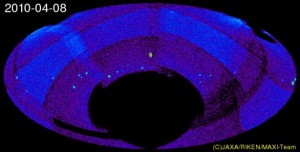
The
all-sky image taken on April 8, 2010, after the ISS turn-back. The
north camera covers the south region, making a blank near the galactic
center.






